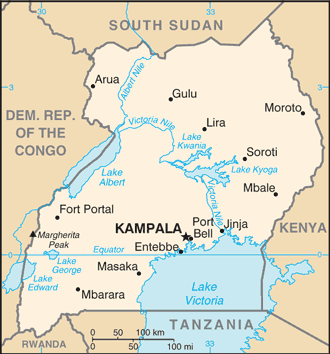NewsDesk @bactiman63
The Uganda Ministry of Health has declared the Budongo (Masindi, Hoima, Buliisa) and Bwindi (Kisoro,
Rubanda, Kanungu) foci as free of river blindness transmission and reclassified the last endemic area, Lhubiriha focus (Kasese district), as suspected transmission interruption.

The 15th meeting of the Uganda Onchocerciasis Elimination Expert Advisory Committee (UOEEAC) of the Ministry of Health held from 3rd to 5 th August 2022 at Sheraton Hotel, Kampala concluded that two more river blindness foci have met the World Health Organization (WHO) criteria for eliminating transmission following three years of active surveillance for any infection after halting ivermectin mass treatment.
The two foci are the Budongo (Buliisa, Hoima, Masindi districts) with 192,922 people, and Bwindi (Kisoro, Rubanda, Kanungu districts) with 148,862 people.
Budongo and Bwindi join the 11 foci that previously eliminated disease transmission in Uganda. Those foci and their respective districts include: Itwara (Kyenjojo and Kabarole); Elgon (Mbale, Sironko, Manafwa, Namisindwa and Bududa); Mpamba-Nkusi (Kagadi); Wambabya-Rwamarongo (Hoima and Kikuube); Kashoya-Kitomi (Kitagwenda, Rubirizi, Buhweju and Ibanda); Imaramagambo (Bushenyi and Mitooma); Obongi (Obongi); Wadelai (Pakwach), West Nile (Koboko and Yumbe), Nyamugasani (Kasese) and Victoria Nile (Jinja, Mukono, Kamuli, Mayuge and Kayunga). As of August 2022, it is estimated that 5,258,881 people are no longer at risk of onchocerciasis, including 2,965,067 living in the Victoria Nile focus.
In addition to the 14 foci where elimination has been confirmed or provisionally confirmed, the Nyagak-Bondo (Nebbi, Arua, Zombo, and Madi-Okollo) focus achieved interruption of river blindness transmission and stopped interventions in 2019 and is undergoing three years of posttreatment surveillance per the WHO guidelines. In total, river blindness transmission interruption and elimination have been attained in 15 of the 17 foci, and 5,906,076 Ugandans living in these districts are no longer at risk of acquiring the disease.
The committee also provisionally reclassified the Maracha-Terego focus (Maracha and Teregov districts) as transmission eliminated pending confirmatory investigations. If fully endorsed, an additional 225,087 people will be declared free from River Blindness. The Government of Uganda launched the national onchocerciasis elimination policy in 2007 with complementary vector control and mass treatment bi-annually of affected communities with ivermectin (Mectizan® donated by Merck & Co., Inc.) as part of the interventions.
The Lhubiriha focus (Kasese district), with a population of 149,225, was reclassified from transmission ongoing to suspected transmission interruption after 34 rounds of effective treatment since 1997 and near-elimination of the blackfly vectors. Interventions will continue in Lhubiriha until criteria to stop treatment are met. They also continue in the Madi-Mid North focus (Pader, Lamwo, Kitgum, Gulu, Omoro, Amuru, Nwoya, Oyam, Lira, Adjumani, and Moyo districts), with a total population of about 1,598,315 people that is also classified as “suspected interruption of transmission.”
River blindness is a devastating public health problem previously affecting about 4.9 million people in 43 districts of Uganda, excluding districts in the Victoria Nile focus, which achieved elimination in the early 1970s. The disease is transmitted by black flies that breed in fast-flowing rivers. It causes severe eye and skin diseases that may result in blindness. A river blindness transmission focus is a geographical area with the same transmission source, which can be a small portion of a district or one or more districts.
- Brazil dengue deaths top 800, São Paulo accounts for three out of ten deaths
- Echinococcus infection reported in woman near Moscow
- Zimbabwe measles outbreak: 698 deaths reported since April
- Argentina Legionella: WHO report, Latest from Tucumán
- Philippines FDA warns of fake anti-rabies serum
- San Diego: MTS rider diagnosed with TB
- New Jersey: 2 additional Legionnaires’ Disease cases reported in Hamilton Township


One thought on “Uganda: Budongo and Bwindi declared free of river blindness”